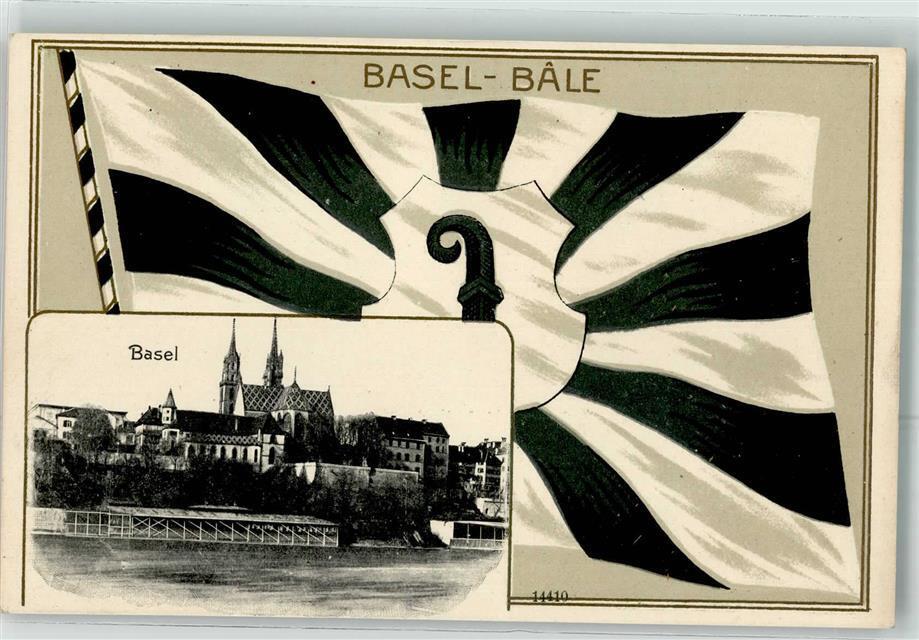![[Flag of Basel-Stadt]](../images/c/ch-bs.gif) image
by António Martins
image
by António Martins
Last modified: 2025-06-27 by martin karner
Keywords: switzerland | basel | basel-stadt | german | half-canton |
Links: FOTW homepage |
search |
disclaimer and copyright |
write us |
mirrors
Argent, a bishop's crozier sable.
On a white field, a black bishop's crozier, with the crook turned
toward the hoist.
T.F. Mills, 22 October 1997
The bishop's crozier has three well accepted meanings since early
Christianity: It is a support or guide (the shepherd's crook that
saves straying sheep), an emblem of authority and ministration, and a
instrument of punishment and correction.
The crozier is highly stylised (thickened and
shortened beyond recognition), and its peculiar heraldic shape was
well established by 1249. The three-pronged foot represents a very
real spike on pastoral staffs which permitted planting them in the
ground.
T.F. Mills, 22 October 1997
The Bishopric of Basel, founded in 346 AD by Justitian, was the
oldest and most important bishopric of the upper Rhine. The
city state became sovereign within the Holy Roman Empire in 1356 when
the city bought its civic rights from the bishop. The crozier was
originally red, but probably changed to black in 1356. Basel joined
the Swiss confederation in 1501.
T.F. Mills, 22 October 1997
Flaggen, Knatterfahnen and Livery Colours |
||
![[Knatterfahnen]](../images/c/ch-bs_kf.gif)
|
||
Flaggen are vertically hoisted from a crossbar in the manner of gonfanon, in ratio of about 2:9, with a swallowtail that indents about 2 units. The chief, or hoist (square part) usually incorporates the design from the coat of arms – not from the flag. The fly part is always divided lengthwise, usually in a bicolour, triband or tricolour pattern (except Schwyz which is monocolour, and Glarus which has four stripes of unequal width). The colours chosen for the fly end are usually the main colours of the coat of arms, but the choice is not always straight forward.
Knatterfahnen are similar to Flaggen, but hoisted from the long side and have no swallow tail. They normally show the national, cantonal or communal flag in their chiefs.
Željko Heimer, 16 July 2000
See also: HANGING FLAG, VERTICALLY HOISTED FLAG, LIVERY COLOURS in Dictionary of Vexillology
![[Rectangular version of Basel-Stadt flag]](../images/c/ch-bs1.gif) image by António Martins
image by António Martins
Observed during the 2002 Under-21 European Football Championship, held in Switzerland.
Jorge Candeias, 22 February 2002
Simple rectangular cantonal flag, as shown in Mader (1942) (So-called
colour flag [Farbenfahne in German]).
Martin Karner
See also: STATE COLOURS in Dictionary of Vexillology

 images located by Martin Karner
images located by Martin KarnerAt the beginning of the 20th century, flamed flags were still in use, with the white cross replaced by
a (baroque) shield in the centre of the flag. These decorative flags had been used until WWII and then
somewhat forgotten in preference of the current cantonal flags. [Today they are being
produced again, see below]
[Photos above: #1: postcard, ca. 1910; #2: Group of youth organisation, postcard, ca. 1940]
Pascal Gross, 30 June 2002
![[Flamed flag of Basel-Stadt]](../images/c/ch-bs_fl.jpg) image located by Martin Karner
image located by Martin Karner
This flamed Basel flag was seen on the Basel Tattoo Parade in 2015. This parade is carried out
during the annual Basel Tattoo with the participant groups and guest groups on the streets of Basel.
(picture; source: DVD "Basel Tattoo 2015", SRF)
Martin Karner, 2 November 2023
See also:
logo.jpg) image located by Martin Karner (8 May 2024)
image located by Martin Karner (8 May 2024) image located by Martin Karner
image located by Martin KarnerCockade for the cantonal troops' headgear (regulation from 1898, size: ca. 35 mm, reverse side).
Martin Karner, 14 March 2025
See also: Cockades (Swiss Army)